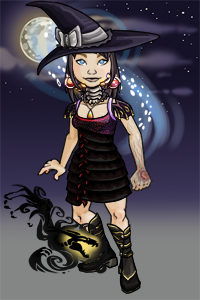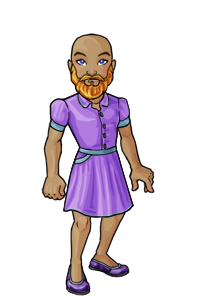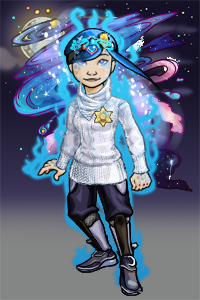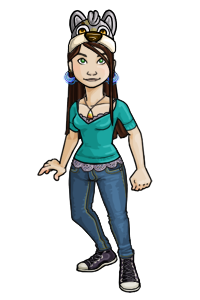|
12:05am Jun 30 2011 (last edited on 12:08am Jun 30 2011)
|
 Normal User
Normal User

Posts: 1,161
|
Hello everybody, my name, as you can see, is De. I'm here to welcome you to the world of Arakera. Arakera has a range of discovered species, although about eight percent of the species still remain undiscovered. There is one more thing you will most certainly need to know. You can own an Arakerian. ----------------------------------- Posts; Post One - Introduction Post Two - Arakera Post Three - Arakerian Species Post Four - Rules Post Five - The Tree Post Six - The Black Market
BUYING GINGER VASPI!\r\ndeviantart: punkeon |
|
12:06am Jun 30 2011 (last edited on 3:38am Jun 30 2011)
|
 Normal User
Normal User

Posts: 1,161
|
Arakera ● What does Arakera look like? Arakera is a small planet, about the size of Pluto. It's like a rainforest on the bottom, covered in small trees, and green undergrowth. It consists of millions of giant, twisted trees, each usually more than one thousand years old. These trees are called Gian. The Gian are about two kilometers high, and are fifty to one hundred meters thick each. They are each about two hundred meters apart, as to not bunch up, or block all the light. Due to their age, the twists and veins sticking out of the tree have grown to about one meter out of the tree, making the perfect walking path for the inhabitants of Arakera that live in the Gian. Going back to the bottom, three quarters of Arakera is rainforest. It looks just like the amazon rainforest if you compare the two. The last quarter is a huge field. There is a river that separates Arakera into two halves, named the Spyal River. All of the bottom-dwellers drink from this river, or settle for puddles in the leaves. However the canopy-feeders drink from puddles that fill carved out veins, to create a bowl. Every ten meters or so on a Gian, is a bunch of veins sticking out to create almost a balcony. This is where the canopy-feeders live. A small cave, about a meter in, is also naturally carved in, and provides shelter to the canopy-feeders. As for the bottom-dwellers, they have caves as well, but these are made of stone. ● How do the bottom-dwellers & canopy-feeders act towards each other? The two classes hardly ever come into contact with each other, but sometimes, when a canopy-feeder gets curious and creeps down out of his/her Gian, or a bottom-dweller climbs up a Gian, the bottom-dwellers/canopy-feeders will chase the stray back up, or down, to their own territory. This usually happens, although, if a little one is hurt climbing up, or falling down, the opposite class will raise it as their own, train it their ways, and allow it to live with them. ● How do the bottom-dwellers get food? Bottom-dwellers get food by either eating the luscious leaves, grass, and vegetables, or hunting small prey. Prey includes the Malf, the Hain, and the Reisa. Hain are the biggest species of prey, being about the size of a large beaver. The Reisa are the second largest, and second smallest, at the size of a domestic rabbit. The Malf are the size of a mouse, and are the smallest species of prey. The leaves and vegetables that the bottom-dwellers eat are the the leaves of the Dripdo, the leaves of the Sirda, the vegetable Trenp, and the fruit Yer. Dripdo leaves are soft, and the size of an average male's hand. Sirda leaves are spiky, though only in appearance, as they are silky in feel. Trenp is a vegetable like an egg plant, but circle-shaped, and electric blue. Yer is a sweet, pink fruit, with a hard oval outside, and a squishy, juicy inside. ● How do the canopy-feeders get food? Canopy-feeders can also hunt, and eat vegetarian. They all have to be omnivorous in order to survive, especially the ones at the top. Very few things fly up there, although there is a few species of climbers. Climbers can climb higher than the canopy-feeders, seeing as they are meant for climbing. Climbers are small, fluffy monkeys, the size of a cat, typically having brown fur, a white chest, reddy-brown cheeks, and a bushy brown tail. Also available to the canopy-feeders is the delicious Ocris. Ocris are flowers that only grow on Gian. Their petals are a magnificent pink. They have a yellow substance, almost identical to honey in them. The canopy-feeders often eat the Ocris for a sweet snack as one of them just wouldn't satisfy a canopy-feeder's belly.
BUYING GINGER VASPI!\r\ndeviantart: punkeon |
|
12:06am Jun 30 2011 (last edited on 3:19am Jul 3 2011)
|
 Normal User
Normal User

Posts: 1,161
|
Species ● The Aksa Life Span - 20-50 years in the wild, however, if kept in captivity the aksa live up to 80 years. Gender percentage - 60% male, 40% female. Reproduction rate - 1-2 montre (children) every four years. Class - Bottom-dweller The Aksa is a fairly shy inhabitant of Arakera, and thinks twice before approaching someone or something unknown. Being one of the first species of Arakera, it has evolved to suit itself to the conditions it must withstand. The ancient tribe people of Arakera found the aksa frightening, and vicious, but really, the aksa are loving, and loyal. They were hunted for their meat, and skin. Being a reptile, they don’t have fur, and look something like a dinosaur that walks on four legs. In order to eat, they stretch up on their hind legs, as to reach the highest leaves. They can’t eat anything except for leaves, grass, and other vegetarian foods, because of their teeth, which they basically just have a whole lot of molars. When the mating season comes, the males have vicious fights over females, using their horns and claws to defeat the competing male. There isn’t enough adult females to allow every adult male to mate, and a lot will be left wifeless. When the montre (babies) are born, the female aksa relies completely on her mate for food, as they usually settle into a grassless cave, for protection. The montre will not eat grass until he or she is five months old, relying on her or his mothers milk, and to get milk, the mother must eat. Many montre die, especially if they are born in the winter. When the female’s montre is ready to walk, the male abandons her, and she will call out to other females, and they will gather together, becoming friends, and helping each other protect their montre. New mothers will often gather together, and work out a call, so when they get separated they can call out to each other, and the group will find them. The females stay like this until the next mating season, where they split apart, then find each other again, using their specific calls. -------------------------- ● The Carctes Life Span - 10-30 years in the wild, however, kept in captivity they can live up to 50 years. Gender Percentage - 40% male, 60% female Reproduction rate - 1-6 Drohos (Children) every five years. Class - Bottom-dweller The Carctes is the only mammal that are currently available for adoption that lives on the bottom of Arakera. They are shy, and will sneak past you or spy on you easily. Being a mammal, the carctes needs sunlight, and that is why they live on the field of arakera, where no Gian grow. Even so, they still have very thick coats that keep them warm in winter. If they feel threatened, the feathers on their back rise like a peacocks, and they will warn off the thing threatening them. This species is omnivorous. They will eat live prey, and eat berries and the other vegetarian foods. When the carctes' mating season arrives, they all gather to the middle of the field, young females who have not mated before will find themselves a young male that has not mated before. However, the older females that have mated, have a life-long mate that stays with them, their whole life, unless killed. If their mate has been killed, or is no longer with them, they find the opposite gender that the same thing has happened to, to become mates, or, they will settle for a young male. When their Drohos are born, the parents will take turns looking after them, one taking care of the Drohos, while the other goes out hunting for them both. When the Drohos are ready, they will leave their parents, and occasionally meet with them. So carctes are quite similar to humans, if you think about it. -------------------------- ● The Sapen Life Span - 80-150 years in the wild, however, Sapen can reach up to 200 years in captivity. Gender Percentage - 50% male, 50% female Reproduction Rate - 1-3 Russe every 40 years. Class - Bottom-dweller The sapen are a wise, majestic arakerian, and are the most beautiful bottom-dwellers of all. They are reptiles, although they fur long fur tracing their whole underside. The sapen only believe in eating herbivorously, as they would not dream of harming another living creature. Their favorite food is Yer. When mating season comes, the young male with the longest fur attracts all of the young females around, and he chooses which one will become his life-long mate. When he determines that, the females crowd around the male with the second longest fur and so on. Sapen are like the Carctes, choosing one life-long mate that never leaves their side, unless completely necessary. The females Russe are born intelligent and develop their brain as they grow up. Russe are extremely vulnerable to the predators living on the bottom, as a lot of carnivorous arakerians would do anything to get a taste of one. That is why the Russe leave their parents when they are a whole year old. No arakerian would try to get their claws on a fully-grown sapen, as every one that has, has died shortly after. -------------------------- ● The Dreyquin Life Span: 50-90 years in the wild, up to 120 years in captivity. Gender Percentage - 55% male, 45% female Reproduction Rate - 1 egg every 60 years. Class - Canopy-feeder The Dreyquin are an intelligent, slinky species, that live right up in the very top of Gian with their families. They are dragon-like, and look like a skink with giant thin wings. Dreyquin can literally live without stopping down, if they were to never reproduce, or have a family. Their huge wings would make it easy for them to glide around the whole of arakera asleep. When they are old enough to mate, they will lay one, oval egg, that has a smooth, crystal like texture. The males abandon the female immediately after mating, and she is left to fend for herself, and her precious egg. When the Dreyling hatches, it's mother also immediately abandons it, and it has to learn the ways of Arakera by itself. Many Dreyling die, and only the strongest survive. -------------------------- ● The Frenzis Life Span - 30-50 years in the wild, although can reach 70 years in captivity. Gender Percentage - 50% male, 50% female Reproduction Rate - 2-4 plaffe every ten years. Class - Canopy-feeder The frenzis may look scary, and they can be a little crazy at times, but really, they are big sweet-hearts. They are a fox-like species, with feathers growing on different parts of their bodies, including their medium sized wings. When mating season arrives, the female pairs up with a male she is impressed by. The male will stay with her until her plaffe are ready to leave the nest. When her plaffe are born, she nurses them as well as any mother would. The plaffe need to be taught by their mother to fly, so they are prepared for leaving the nest. When they leave, the mother takes her chance and soars around, getting her sense of freedom back.
BUYING GINGER VASPI!\r\ndeviantart: punkeon |
|
12:06am Jun 30 2011 (last edited on 2:10am Jul 4 2011)
|
 Normal User
Normal User

Posts: 1,161
|
Rules Yes rules. -Waits for groans to die down- All good adoptables should have rules, as the creator doesn't want people going mental all over their hard-work of a thread. Well, I'll get onto it. Dos: ● Own up to two adoptables ● Trade adoptables ● Name your adoptable ● Use your adoptable on other sites giving me credit ● Use your design on other animals ● Morph your adopt up to three times ● Add accessories to your adoptable ● Breed your adoptable with somebody elses, or another one ● Give me critique on my work ● Suggest some add-ons ● Be creative! Don'ts: ● Claim as your own art ● Steal any of the creature designs/visible designs ● Use your adoptable in a selfish or rude way ● Make fun of my designs or lines. ● Swear, or do anything rescreatu doesn't allow. --------------------- If you are found doing any of the 'Don'ts', your adoptable will be taken from you and put up for adoption, your tu will be sent back, you will be asked to leave to leave the thread, and you will be ignored if you post again.
BUYING GINGER VASPI!\r\ndeviantart: punkeon |
|
12:06am Jun 30 2011 (last edited on 5:59pm Jul 9 2011)
|
 Normal User
Normal User

Posts: 1,161
|
The Adoption Tree AKA: The Pound. This great gian has nests all through it! I wonder what eggs are in them? Let's take a look! The adoption tree is totally empty! {{ Ignore the numbers, they are there for me. }} These eggs have white tape on them. On the white tape it says something; 20k. Ah! These eggs must be 20k each!
BUYING GINGER VASPI!\r\ndeviantart: punkeon |
|
12:07am Jun 30 2011 (last edited on 3:52pm Jul 4 2011)
|
 Normal User
Normal User

Posts: 1,161
|
The Black Market The black market doesn't have anything in stock currently!
BUYING GINGER VASPI!\r\ndeviantart: punkeon |
|
5:09am Jun 30 2011
|
 Normal User
Normal User

Posts: 128
|
Can Arakeras/aksas fire LAZORZ?
|
|
3:31pm Jun 30 2011
|
 Normal User
Normal User

Posts: 1,161
|
No sorry. And Aksa are just a species of Arakerian. xD I haven't finished the rest.
BUYING GINGER VASPI!\r\ndeviantart: punkeon |
|
3:43pm Jul 1 2011
|
 Normal User
Normal User

Posts: 1,161
|
Bump. I haven't yet finished but I don't want this thread to get lost. xD
BUYING GINGER VASPI!\r\ndeviantart: punkeon |
|
2:44am Jul 4 2011
|
 Normal User
Normal User

Posts: 1,161
|
Bump.
BUYING GINGER VASPI!\r\ndeviantart: punkeon |
|
4:17pm Jul 4 2011
|
 Normal User
Normal User

Posts: 1,588
|
Am I allowed to adopt an egg De? :3

Do not talk to me or my snails ever again. |
|
8:44pm Jul 4 2011
|
 Normal User
Normal User

Posts: 3,950
|
How much do these cost? o3o
- ☀ -
hiiii. you can call me ice.
bands took over my life and
i laugh too hard at bad jokes.
meh. x
- ☀ -
|
|
11:29pm Jul 4 2011
|
 Normal User
Normal User

Posts: 1,161
|
Oh yes, sorry. They cost 20k each. :3 Yes Lake. :D
BUYING GINGER VASPI!\r\ndeviantart: punkeon |
|
3:30pm Jul 7 2011
|
 Normal User
Normal User

Posts: 1,161
|
Bump.
BUYING GINGER VASPI!\r\ndeviantart: punkeon |
|
3:38pm Jul 7 2011
|
 Normal User
Normal User

Posts: 1,588
|
i will buy an egg... 2 if allowed <3

Do not talk to me or my snails ever again. |
|
1:58am Jul 8 2011
|
 Normal User
Normal User

Posts: 1,161
|
Okay Lake. c; I'll hatch the eggs.
BUYING GINGER VASPI!\r\ndeviantart: punkeon |
|
12:25pm Jul 8 2011
|
 Normal User
Normal User

Posts: 3,950
|
Hm.. if Lake didn't take the second egg, may I have it? [the yellow, cream, and dark brown one]
- ☀ -
hiiii. you can call me ice.
bands took over my life and
i laugh too hard at bad jokes.
meh. x
- ☀ -
|
|
3:42pm Jul 8 2011
|
 Normal User
Normal User

Posts: 1,588
|
Can't wait to see what they are ;D I loved the Egg 3's design <3

Do not talk to me or my snails ever again. |
|
5:57pm Jul 9 2011 (last edited on 5:57pm Jul 9 2011)
|
 Normal User
Normal User

Posts: 1,161
|
{Lakeore} Congratulations! Your egg (03) has hatched into a female Carctes! 
Congratulations! Your egg (01) has hatched into a male Frenzis! 
BUYING GINGER VASPI!\r\ndeviantart: punkeon |
|
6:01pm Jul 9 2011
|
 Normal User
Normal User

Posts: 3,950
|
;o; No eggies for me now. Ah well. I'll come back when the tree is restocked.
- ☀ -
hiiii. you can call me ice.
bands took over my life and
i laugh too hard at bad jokes.
meh. x
- ☀ -
|
|